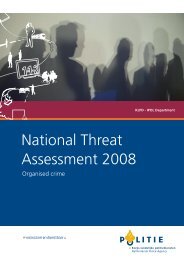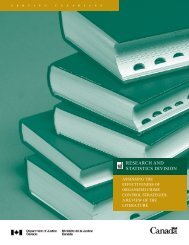Integrating Refugee and Asylum-seeking Children - Center for the ...
Integrating Refugee and Asylum-seeking Children - Center for the ...
Integrating Refugee and Asylum-seeking Children - Center for the ...
Create successful ePaper yourself
Turn your PDF publications into a flip-book with our unique Google optimized e-Paper software.
comparative report: educational integration of refugee <strong>and</strong> asylum-<strong>seeking</strong> 47<br />
The term ‘politics’ refers to <strong>the</strong> instrumentalisation<br />
of immigration by political actors <strong>and</strong> <strong>the</strong> role<br />
of (anti-)immigration discourse <strong>for</strong> <strong>the</strong> political<br />
identity <strong>and</strong> strategy of a number of parties in<br />
various countries. This dimension remains beyond<br />
<strong>the</strong> scope of <strong>the</strong> present study, but is crucial<br />
<strong>for</strong> making sense of public policies. The political<br />
discourse defines <strong>the</strong> priorities <strong>and</strong> opens or<br />
restricts policy-makers’ horizons. In Norway <strong>and</strong><br />
Denmark right-wing parties have streng<strong>the</strong>ned<br />
<strong>the</strong>ir positions. 36 In Sweden <strong>the</strong> party ‘Sweden<br />
Democrats’ entered <strong>the</strong> Parliament (2010) with a<br />
very conservative agenda to dramatically revise<br />
<strong>the</strong> migration policy, which <strong>the</strong>y qualified as “too<br />
permissive <strong>and</strong> generous.” 37<br />
The securitisation of immigration policy in <strong>the</strong> last<br />
decade also strongly influences <strong>the</strong> modalities,<br />
<strong>for</strong>ms <strong>and</strong> funding of integration. The UK clearly<br />
illustrates this trend. The drive of <strong>the</strong> previous British<br />
government <strong>for</strong> a comprehensive refugee integration<br />
policy led in 2004 to <strong>the</strong> issuing of “Aiming High:<br />
Guidance on Supporting <strong>the</strong> Education of <strong>Asylum</strong>-<br />
Seeking <strong>and</strong> <strong>Refugee</strong> <strong>Children</strong>.” “The change of<br />
government in 2010 led to <strong>the</strong> archiving of national<br />
good practice guidelines <strong>and</strong> <strong>the</strong>ir removal from<br />
<strong>the</strong> website of <strong>the</strong> Department <strong>for</strong> Education.<br />
These good practice guidelines are no longer<br />
being promoted.” 38 In several countries <strong>the</strong> reports<br />
identify two opposite trends: <strong>the</strong> societies have<br />
become more diverse in terms of demography,<br />
work<strong>for</strong>ce <strong>and</strong> cultural practices, yet politicians are<br />
increasingly hostile to multiculturalism. Hopefully,<br />
<strong>the</strong> INTEGRACE project will introduce a more<br />
reasonable note into this discourse by showcasing<br />
good practices of openness <strong>and</strong> inclusion.<br />
<strong>the</strong> term ‘policies’ refers to a variety of public<br />
policies, some of which are specifically educational<br />
<strong>and</strong> concern <strong>the</strong> inclusion <strong>and</strong> integration of<br />
migrant <strong>and</strong> refugee children. The State has primary<br />
responsibility <strong>for</strong> <strong>the</strong> realisation of <strong>the</strong> right to<br />
education. It has <strong>the</strong> obligation to fulfil this right by<br />
“ensuring that education is available <strong>for</strong> all children<br />
<strong>and</strong> positive measures are taken to enable children<br />
to benefit from it.” 39 Governmental agencies should<br />
be held accountable <strong>for</strong> <strong>the</strong> access <strong>and</strong> quality of<br />
education. UNESCO sets <strong>the</strong> st<strong>and</strong>ards <strong>for</strong> a good<br />
policy of educational integration: transparency,<br />
accountability, access to justice <strong>and</strong> stakeholder<br />
participation. 40 Norway provides an original example<br />
of institutionalisation of governmental accountability<br />
by employing an Ombudsman <strong>for</strong> children.<br />
Although <strong>the</strong> Ombudsman is administratively under<br />
<strong>the</strong> jurisdiction of <strong>the</strong> Ministry <strong>for</strong> <strong>Children</strong> <strong>and</strong><br />
Family Affairs, nei<strong>the</strong>r <strong>the</strong> Norwegian Parliament<br />
nor <strong>the</strong> Government have <strong>the</strong> power to instruct <strong>the</strong><br />
Ombudsman. The duties of <strong>the</strong> Ombudsman are<br />
to promote <strong>the</strong> interests of children vis-à-vis public<br />
<strong>and</strong> private authorities. 41<br />
Our analysis emphasises three groups of political<br />
factors which have an impact on educational<br />
integration, <strong>and</strong> measures <strong>the</strong>ir degree of relevance.<br />
The first group of factors concerns <strong>the</strong> issue of<br />
integration <strong>and</strong> <strong>the</strong> way it is articulated in political<br />
discourse. The second sheds light on <strong>the</strong> political<br />
interest in strategies <strong>and</strong> programmes guiding public<br />
policies. The third asks <strong>the</strong> question how <strong>the</strong><br />
centralisation or decentralisation of education <strong>and</strong><br />
integration practices influences <strong>the</strong>ir effectiveness.<br />
The concept of integration has different political<br />
visibility in <strong>the</strong> countries which have been analysed.<br />
In some, it enjoys clear legal <strong>and</strong> political definitions<br />
<strong>and</strong> is articulated in activities, assigned responsibilities,<br />
<strong>and</strong> timetables in strategies <strong>and</strong> programmes. In<br />
o<strong>the</strong>rs, such as Malta, no integration plan has been<br />
developed.<br />
There<strong>for</strong>e, two opposite cases can be identified.<br />
The Maltese one illustrates <strong>the</strong> first, a negative<br />
36 However, <strong>the</strong> September 2011 elections in Denmark seem to have called a halt to this shift. The mass murders by Anders Breivik<br />
in Norway in July 2011 also led to a backlash against extreme right-wing politicians.<br />
37 Country Report: Sweden.<br />
38 Country Report: United Kingdom.<br />
39 UNICEF <strong>and</strong> UNESCO (2007), A Human Rights-Based Approach to Education <strong>for</strong> All – A Framework <strong>for</strong> <strong>the</strong> Realization of <strong>Children</strong>’s<br />
Right to Education <strong>and</strong> Rights within Education. UNICEF/UNESCO, 2007, p. 39. Available at: http://unesdoc.unesco.org/images/<br />
0015/001548/154861e.pdf<br />
40 UNICEF <strong>and</strong> UNESCO (2007), A Human Rights-Based Approach to Education <strong>for</strong> All – A Framework <strong>for</strong> <strong>the</strong> Realization of <strong>Children</strong>’s<br />
Right to Education <strong>and</strong> Rights within Education. UNICEF/UNESCO, 2007, p. 122. Available at: http://unesdoc.unesco.org/images/0015/<br />
001548/154861e.pdf<br />
41 Country Report: Norway.








